英语第9单元
七年级下册英语第九单元作文范文(必备10篇)
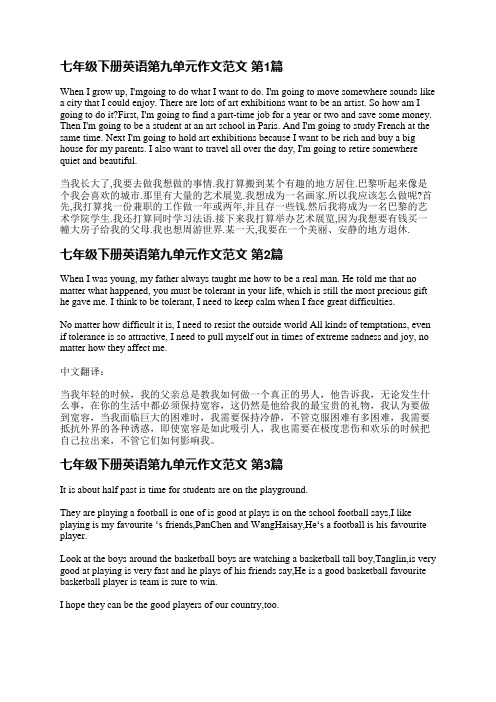
When I grow up, I'mgoing to do what I want to do. I'm going to move somewhere sounds like a city that I could enjoy. There are lots of art exhibitions want to be an artist. So how am I going to do it?First, I'm going to find a part-time job for a year or two and save some money. Then I'm going to be a student at an art school in Paris. And I'm going to study French at the same time. Next I'm going to hold art exhibitions because I want to be rich and buy a big house for my parents. I also want to travel all over the day, I'm going to retire somewhere quiet and beautiful.当我长大了,我要去做我想做的事情.我打算搬到某个有趣的地方居住.巴黎听起来像是个我会喜欢的城市.那里有大量的艺术展览.我想成为一名画家.所以我应该怎么做呢?首先,我打算找一份兼职的工作做一年或两年,并且存一些钱.然后我将成为一名巴黎的艺术学院学生.我还打算同时学习法语.接下来我打算举办艺术展览,因为我想要有钱买一幢大房子给我的父母.我也想周游世界.某一天,我要在一个美丽、安静的地方退休.七年级下册英语第九单元作文范文第2篇When I was young, my father always taught me how to be a real man. He told me that no matter what happened, you must be tolerant in your life, which is still the most precious gift he gave me. I think to be tolerant, I need to keep calm when I face great difficulties.No matter how difficult it is, I need to resist the outside world All kinds of temptations, even if tolerance is so attractive, I need to pull myself out in times of extreme sadness and joy, no matter how they affect me.中文翻译:当我年轻的时候,我的父亲总是教我如何做一个真正的男人,他告诉我,无论发生什么事,在你的生活中都必须保持宽容,这仍然是他给我的最宝贵的礼物,我认为要做到宽容,当我面临巨大的困难时,我需要保持冷静,不管克服困难有多困难,我需要抵抗外界的各种诱惑,即使宽容是如此吸引人,我也需要在极度悲伤和欢乐的时候把自己拉出来,不管它们如何影响我。
人教版七年级上册英语单词第9单元

人教版七年级上册英语单词第9单元当今时代,英语已经成为一种多国、多文化,多功能的国际语言。
英语单词是七年级英语学习最基本的要素之一,对英语学习起着举足轻重的作用。
下面小编给大家分享一些人教版七年级上册英语单词,大家快来跟小编一起欣赏吧。
人教版七年级上册英语单词:第9单元go v. 去movie n. 电影go to a movie 去看电影action n. 动作片comedy n. 喜剧documentary n. 记录片thriller n. 恐怖电影或小说kind n. 种类singular n. 单数;单数形式a.单数的plural n. 复数;复数形式a.复数的;opera n. 歌剧Beijing Opera 京剧find v. 寻找;查找someone pron. 某人who pron. …的人student n. 学生scary a. 可怕的;吓人的funny a. 有趣的;好玩的sad a. 悲哀的;悲伤的exciting a. 令人激动的;振奋人心的really ad. 事实上;无疑地;真正地often ad. 时常;常常think v. 认为;想;思考learn v. 学习;学会about prep. 关于;涉及;在…方面history n. 历史with prep. 与…在一起;和;使用…工具;有;附有favorite a.最喜爱的actor n. 演员new a. 新的successful a. 成功的weekend n. 周末too adv 也;又太Rush 电影《尖峰时刻》Mr. Bean 电影《憨豆先生》Shaolin temple 电影《少林寺》Ben 本(男名)Maria 玛丽亚(女名)Michelle 米歇尔(女名)June 琼(女名)Edward 爱德华(男名)Jackson 杰克逊(姓)Rick 瑞克(男名)Jackie 杰克(男名)Rowan Atkinson 罗温艾金森Jet 杰特(男名)人教版七年级上册英语单词(一)like v. 喜欢banana n. 香蕉hamburger n. 汉堡包tomato n. 西红柿broccoli n. 花椰菜French fries 炸马铃薯条;薯条orange n. 橙子ice n. 冰cream n. 奶油; 乳脂ice cream n. 冰淇淋salad n. 沙拉strawberry n. 草莓pear n. 梨have aux. 吃;饮oh int. 啊;呀;哦countable noun 可数名词uncountable noun 不可数名词food n. 食物egg n. 鸡蛋apple n. 苹果carrot n. 胡萝卜chicken n. 鸡;鸡肉breakfast n. 早餐lunch n. 午餐dinner n. 晚餐;正餐fruit n. 水果vegetable n. 蔬菜;植物runner n. 奔跑者eat v. 吃well adv. 好、对、满意地run v. 跑、奔跑star n. 星星;明星lot adv. 许多lots of 大量;许多…healthy a. 健康的;强健的dessert n. (饭后的)甜食list n. 清单Bill 比尔(男名)Sandra 桑德拉(女名)Clark 克拉克(姓)Review of units 1-6furniture n. 家具(总称)people n. 人;人民an art. 一个(只;把;台…)blank n. 空白conversation n. 交谈;谈话other a. 另外的人(物)also adv. 也;亦;并且Joe 乔(男名)人教版七年级上册英语单词(二) guitar n. 吉他join v. 参加;加入dance v. 跳舞;舞蹈swim v. 游泳sing v. 唱;唱歌chess n. 国际象棋paint v. 画画speak v. 说;说话can't=can not 不能kid n. 小孩;年轻人our pron. 我们的drum n. 鼓piano n. 钢琴trumpet n. 喇叭violin n. 小提琴or conj. 或者musician n. 音乐家;擅长音乐的人then ad. 那时;然后be prep. 是(表示存在、状态等) rock n. 摇滚乐band n. 乐队show n.v. 演出;表演展示;给…看Sunday n. 星期日;星期天pm abbr 下午kung fu 中国功夫may n. 可能;可以draw v. 画little pron. 少许;少量a little 少许;少量e-mail n. 电子邮件address n. 通讯外;地址why ad. (疑问副词)为什么Jennifer 詹妮弗(女名)Victor 维克多(男名)Cindy 辛蒂(女名)Jones 琼斯(姓)。
人教版九年级英语第九单元知识点总结

人教版九年级英语第九单元知识点总结Unit 9 I like music that I can dance to. 单词 Prefer lyrics Australia electronic suppose smooth spare director case in that case war stick Stick to to shut shut shut off down down dialog dialog ending documentary dram plenty of of superhero superhero sadness pain moving lifetime pity total in total master recall wound painful once in a while intelligent sense. reflect .perform praise 一.1. dance to music 随着音乐起舞 2. sing along with 随着……一起唱 3. musicians who play play different different kinds kinds of of music music 弹奏不同类型音乐的音乐家 4. 4. electronic electronic music music 电子音乐 5. not much=nothing much 没什么(事) 6. suppose sb. to do sth. 猜想某人做某事 be supposed supposed to to do do sth. sth. 应该做某事 suppose suppose sb sb (to (to be) be) +adj. +adj. 原以为某人是…… 7. 7. have have spare time 有空闲时间 in one's spare time 在某人的空闲时间 spare the time to do sth. 抽时间做…… 8. 8. think think too too much much 想得太多;过度思考 9 9 in in that that case case 既然那样 10. World War II 第二次世界大战 11. smooth music 悦耳的音乐 12. prefer A to B 比起B 来更喜欢A prefer doing A to to doing doing B 愿意去做A 而不是去做B prefer to to do do A A rather than than do do B B 宁愿做A 而不做B 13. 13. feel feel like like doing doing sth. sth. 想要做某事 =want =want to to do do sth. sth. =would like to do sth. 14. stick to 坚持,固守 15. be down 悲哀,沮丧 16. cheer sb up 使…高兴/ 振奋 17. 17. have have a a happy happy ending 有个美满的结局 18. 18. less less serious serious 不那么严重 19. a good way to do sth. 做某事的好办法 20. shut off 关闭 21. in time 及时on time 按时/准时 22. once in a while 偶尔的;有时 =sometimes /at times 23. write one's own lyrics 自己写歌词24. 24. take take sb sb to to sp. sp. 带某人去某地 25. 25. Chinese Chinese folk folk music music 中国民间音乐 26. 26. be be played played on on the the erhu 由二胡演奏的 27. 27. move move sb. sb. 感动某人 (sb. sb. be be moved moved by by sth.sth.) 28.strangely beautiful 异常的/出奇的美 29. sense a strong sadness and pain 感觉到一种强烈的伤感和痛苦 30. the most moving pieces of music 最令人感动的乐曲 31. the city of Shantou = Shantou city 汕头市 32. by age 17 到十七岁的时候 33. musical ability 音乐才能 34. develop a serious illness 得了一种很重的病 35. become blind 成了盲人;变瞎 36. make money 赚钱 37. get married (to sb.) (和某人)结婚 38. continue to do sth. 继续去做某事(另一件事) continue doing sth. 继续继续做着某事(同一件事) 39. perform in this way 用这种形式表演 40. 40. during/ during/ in in one's one's lifetime lifetime 在某人有生之年 41. 41. by by the the end end of ... of ... 到……末为止(时间) at the end of ... 在……尽头/末梢(时间、地点) 42. It's a pity that ... 遗憾的是…… 43. in total 总共 44. be recorded for the future world to hear 被记录下来供后人聆听 45. praise ... for ... 因为……赞美 46. China's national treasures 中国的国家珍宝 47. 47. paint paint a a picture picture of of ... ... 描绘了一幅……画 48. 48. recall recall one's one's deepest deepest wounds 唤起某人最深的伤痛 49. painful experiences 痛苦的经历 50. a time for spreading joy 传播快乐的时间51. 51. live live a a very very hard hard life.过着艰苦的生活。
Unit 9 单元复习知识点课件 人教版英语七年级下册

-- _________.
A. He is thin
B. She is a kind girl
C. She likes music D. She has good-looking
4. -- Lucy doesn’t have curly hair.
-- Yes, we can say she has _______hair.
There are a lot of people in the bus. 公共汽车上有很多人。
3. Also, they don’t always remember well. 而且,他们并不总是记得牢靠。
(1)当also用于句首时,其后往往有逗号与句 子的剩余部分隔开。这时,also用于修饰整 个句子,相当于汉语中“同时;还;而且”。
Unit 9 What does he look like?
单元复习知识点课件
Key sentences for describing people: (描述人的重点句型)
What does he/she look like? 1) He/She is of medium height/tall/short
A. How old is he
B. What does he do
C. What does he look like D. How is he
8. --Tom is not very heavy.
--Yes, I think we can say he is ______ heavy.
A. a little
Ⅰ.补全句子。
1. 他长得什么样?
_W___h_a_t_ __d_o_e_s__ he ___lo_o__k_ __l_ik__e__?
人教版英语九年级unit9 第九单元全单元section B 课件含音频
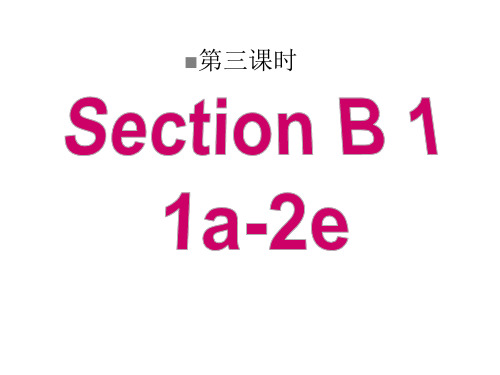
•
阿炳惊人的音乐技能让他在有生之年就非常出名。到他临终前,他已会
弹 600 多首曲子,大部分是他自己写的。遗憾的是,一共只有 6 首曲子被录
了下来得以传世,但时至今日,他(的作品)依旧颇受人们喜爱。今天,阿
炳的《二泉映月》成了所有伟大的二胡演奏家弹奏和赞赏的曲子。它已成为
了中国文化瑰宝之一。 它的凄美不仅描绘出阿炳自己的生活,而且也让人们
• 17 Chinese folk music
中国民族音乐
18 teach sb to do sth
教某人去做某事
19 get married to sb
和某人结婚
20 such as
比如说
• 21 a piece of一块, 一张,一首+不可数名词a piece of music
• 22 by age 17 到17 岁时 at the age of 在17岁时
3. I have friends w__h_o_a_r_e__fr_i_e_n_d_ly__a_n_d__h_e_lp_f_u_l_. 4. I like movie stars
_w_h_o__a_r_e_b_e_a_u_t_if_u_l_o_r_h__a_n_d_s_o_m_e________.
• Section B 2b 凄美
•
昨晚我的一个中国朋友带我去听了一场中国民 间音乐会。其中有一首二
胡曲令我特别感动。音乐 出奇的美,但是在那美的背后,我感受到悲伤和痛
苦。这首曲子有个简单的名字《二泉映月》,但它 是我听过的最感人的曲子
之一。二胡的声音听起来 那么悲伤,以至于我在听的时候也几乎随着它哭了。
don’t s_u_p_p__o_se__ you would want to buy this _el_e_c_tr_o_n_i_c__ music CD. 3. Christmas is a time for spreading joy, so
八年级上册英语第九单元

八年级上册英语第九单元八年级上册Unit9知识点汇总Unit 9 单词prepare [prɪ'per] v.预备;准备exam [ɪɡ'zæm] n.考试available [ə'veɪləbl] a.可得到的;有空的hang [hæŋ] v.悬挂;(使)低垂until [ən'tɪl] conj./prep.直到 ... 的时候;直到…为止catch [kætʃ] v./n.赶上;抓住;捕捉invite [ɪn'vaɪt] v.邀请accept [ək'sept] v.接受refuse [rɪ'fjuːz] v.拒绝invitation [ˌɪnvɪ'teɪʃn] n.邀请;邀请函reply [rɪ'plaɪ] v./n.回答,回复forward ['fɔːrwərd] v.转交;发送adj.向前的adv.向前地delete [dɪ'liːt] v.删除preparation [ˌprepə'reɪʃn] n.准备,准备工作opening ['oʊpnɪŋ] n.开幕式,落成典礼guest [ɡest] n.客人concert ['kɑːnsərt] n.音乐会headmaster [ˌhed'mæstər] n.校长event [ɪ'vent] n.大事,公开活动calendar ['kælɪndər] n.日历,日程表【重点短语】1、on Saturday afternoon 在星期六下午2、have to 必须3、prepare for 准备4、go to the doctor 去看病5、have the flu 患流感6、help my parents 给父母帮忙7、come to the party 参加晚会8、meet my friend 见朋友9、go to the party 参加晚会10、too much homework 太多的家庭作业11、go to the movies 去看电影12、another time 下次,另外的时间,别的时间13、last fall 去年秋天14、hang out 闲逛15、after school 放学后16、on the weekend=on weekends 在周末17、study for a test 备考18、visit grandparents 拜访爷爷奶奶19、the day before yesterday 前天20、the day after tomorrow 后天21、have a piano lesson 上钢琴课22、look after 照看23 make an invitation 制定邀请24、accept an invitation 接受邀请turn down (refuse)an invitation 拒绝邀请25、take a trip to Wuhan 去武汉旅游26、at the end of this month 在本月底27、look forward to + doing 期望/渴望28、the opening of… 开幕/开业29、reply in writing 写回信30、go shopping 购物31、do homework 做作业32、go to the concert 参加音乐会33、not…until… 直到......才......【重点句型】1. --Can you come to my party on Saturday afternoon?星期六下午你能参加我的晚会吗?--Sure, I’d love to. / Sorry,I can’t. I have to prepare for an exam.当然,我愿意去。
五年级上册英语第九单元
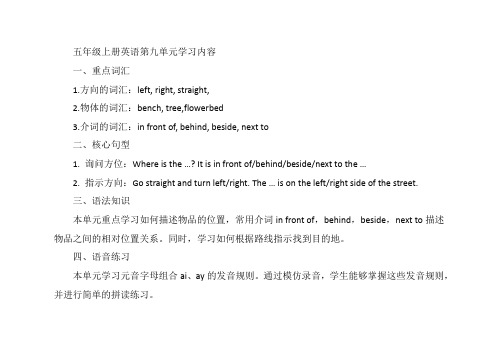
五年级上册英语第九单元学习内容一、重点词汇1.方向的词汇:left, right, straight,2.物体的词汇:bench, tree,flowerbed3.介词的词汇:in front of, behind, beside, next to二、核心句型1. 询问方位:Where is the …? It is in front of/behind/beside/next to the …2. 指示方向:Go straight and turn left/right. The … is on the left/right side of the street.三、语法知识本单元重点学习如何描述物品的位置,常用介词in front of,behind,beside,next to描述物品之间的相对位置关系。
同时,学习如何根据路线指示找到目的地。
四、语音练习本单元学习元音字母组合ai、ay的发音规则。
通过模仿录音,学生能够掌握这些发音规则,并进行简单的拼读练习。
五、文化背景在学习本单元时,学生了解不同国家的交通规则和文化习惯。
例如,了解一些国家驾驶座在右侧,而另一些国家驾驶座在左侧。
此外,学生还可以了解到在不同国家如何使用合适的语言询问方向和获取帮助。
六、实践活动1. 设计地图活动:学生可以绘制一张学校或社区的地图,标注出各个建筑物和设施的位置。
然后,使用所学句型进行描述和指路练习。
2. 角色扮演活动:学生可以分组扮演问路者和指路人,模拟真实生活中的情境进行对话练习。
通过角色扮演活动,学生能够更深入地理解和运用所学知识。
3. 游戏活动:教师可以设计一些关于方位和位置的游戏,如“宝藏猎人”等。
通过游戏活动,学生在轻松愉快的氛围中巩固所学知识,提高英语学习的兴趣。
九年级上册英语第九单元单词

九年级上册英语第九单元单词Unit 9pity/pɪti/遗憾;同情;怜悯drama/'drɑ:mə/戏;剧;戏剧down/daʊn/减少;降低stuck/stʌk/陷住;无法移动stick/stɪk/n.棍;条Australian/ɒ'streɪliən/, /ɔ:'streɪliən/adj.澳大利亚(人)的;n.澳大利亚人case/keɪs/n.情况;实情dialog/'daɪəlɒg/, /'daɪəlɑ:g/n.对话;对白director/də'rektə(r)/, /daɪ'rektə(r)/n.导演;部门负责人electronic/ɪ,lek'trɒnɪk/, /ɪ,lek'trɑ:nɪk/adj.电子的;电子设备的master/'mɑ:stə/, /'mæstər/n.大师;能手;主人;v.掌握pain/peɪn/n.痛苦;疼痛;苦恼painful/'peɪnfl/adj.令人痛苦的;令人疼痛的perform/pə(r)'fɔ:(r)m/v.表演;执行plenty/'plenti/pron.大量;众多praise/preɪz/v.&n.表扬;赞扬prefer/prɪ'fɜ:(r)/v.更喜欢;较喜欢reflect/rɪ'flekt/v.反映;映出sadness/'sædnəs/n.悲伤;悲痛sense/sens/v.感觉到;意识到;n.感觉;意识shut/ʃʌt/(shut的原形和过去式和过去分词)v.关闭;关上smooth/smu:ð/悦耳的;平滑的spare/speə/, sper/空闲的;不用的;v.抽出;留出suppose/sə'pəʊz/v.推断;料想total/'təʊtl/n.总数;合计;adj.总的;全体的war/wɔ:(r)/n.战争;战争状态wound/wu:nd/n.伤;伤口;创伤;v.使(身体)受伤;伤害Carmen/'kɑ:(r)men/卡门(女名)Dan Dervish/dæn 'dɜ:(r)vɪʃ/丹·德维什Kung Fu Panda《功夫熊猫》(电影名)March of the Penguins《帝企鹅日记》(电影名)Men in Black《黑衣人》(电影名)Spider-Man/'spaɪdəmæn/《蜘蛛侠》(电影名)Titanic/taɪ'tænɪk/《泰坦尼克号》(电影名)World War II第二次世界大战documentary/,dɒkju'mentri/, /,dɑ:kju:'mentri/n.记录片ending/'endɪŋ/n.(故事、电影等的)结尾;结局in that case既然那样;假使那样的话in total总共;合计intelligent/ɪn'telɪdʒənt/adj.有才智的;聪明的lifetime/'laɪftaɪm/n.一年;有生之年lyrics/'lɪrɪks/n.(pl.)歌词moving/'mu:vɪŋ/adj.动人的;令人感到的once in a while偶尔地;间或plenty of大量;充足recall/rɪ'kɔ:l/v.回忆起;回想起shut off关闭;停止运转stick to坚持;固守superhero/'su:pə(r),hɪərəʊ/n.超级英雄。
七年级下册英语第九单元知识点
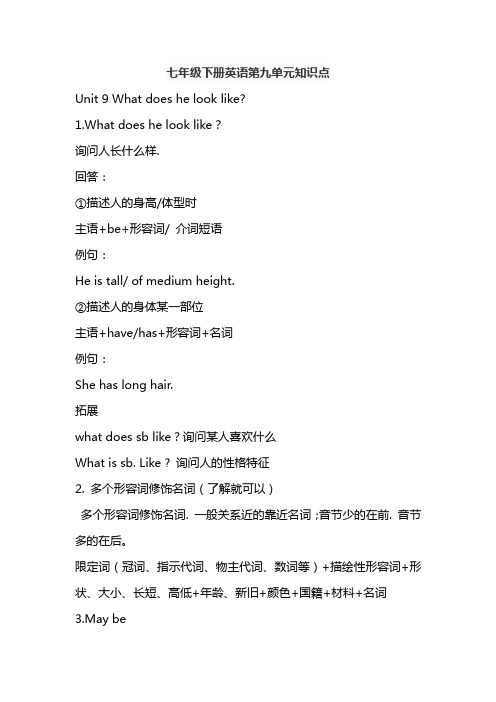
七年级下册英语第九单元知识点Unit 9 What does he look like?1.What does he look like?询问人长什么样.回答:①描述人的身高/体型时主语+be+形容词/ 介词短语例句:He is tall/ of medium height.②描述人的身体某一部位主语+have/has+形容词+名词例句:She has long hair.拓展what does sb like?询问某人喜欢什么What is sb. Like ? 询问人的性格特征2. 多个形容词修饰名词(了解就可以)多个形容词修饰名词. 一般关系近的靠近名词;音节少的在前. 音节多的在后。
限定词(冠词、指示代词、物主代词、数词等)+描绘性形容词+形状、大小、长短、高低+年龄、新旧+颜色+国籍+材料+名词3.May be为情态动词+动词原形. 在句子中做谓语. maybe是副词. 表示可能. 大概. 一般放在句首。
4. little a little few a few用法a little. little修饰不可数名词.●a little表示一点点(肯定).●little表示几乎没有(否定)a few. few修饰可数名词.●a few表示一点点(肯定).●few表示几乎没有(否定)拓展:(1)a little :修饰形容词/副词a little latea little quickly(2)修饰不可数名词a little milk5. go to the cinema=go to the movies去看电影6. glass:玻璃(不可数). 玻璃杯(可数)glasses:眼镜7. a handsome boy一个帅气的男孩a beautiful girl一个漂亮的女孩8. person:人(个体名词. 单数概念)people :人们(集体名词. 复数概念)9. find强调找到的结果.look for强调寻找的过程.10. 问职业:what do you do?what is your job?11. sing ---singeract--actor /actressart---artist12. an interesting job:一份有趣的工作a job :一份工作13. draw a picture of......画一张.......的画像14. talk的用法:(1)talk to/with sb.(2)talk about sth.15. The police put it in newspapers and on television to find him.警察将画像放在报纸和电视上来寻找罪犯。
九年级英语Unit9全单元课件
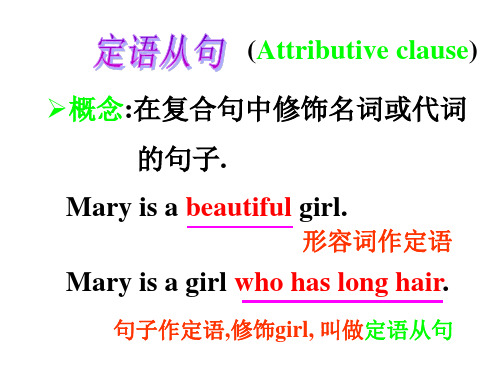
TF TF
3. Carmen likes electronic music that’s loud. T
4. Xu Fei prefers groups that play quiet T F and slow songs.
2b
Carmen says
1,I really love Dan Dervish. I like
10. 清晰的唱出歌词 sing the words clearly
prefer
1.prefer+n.
e.g. I prefer groups that play quiet and gentle songs 2.Prefer sth to sth 比…更喜欢…. e.g. I prefer____ (walk) to running. 3.Prefer to do sth 宁愿做某事 She prefers ____(be) alone at home.
I prefer music that has great lyrics.
I like music that isn’t too loud.
I love music that I can sing along with.
I like music that I can dance to.
1a Look at the picture and circle the sentences you agree with.Then write your own sentence.
4.prefer to do rather than do
She prefers to stay at home rather
Than____(go) shopping.
人教版九年级英语第九单元知识点梳理
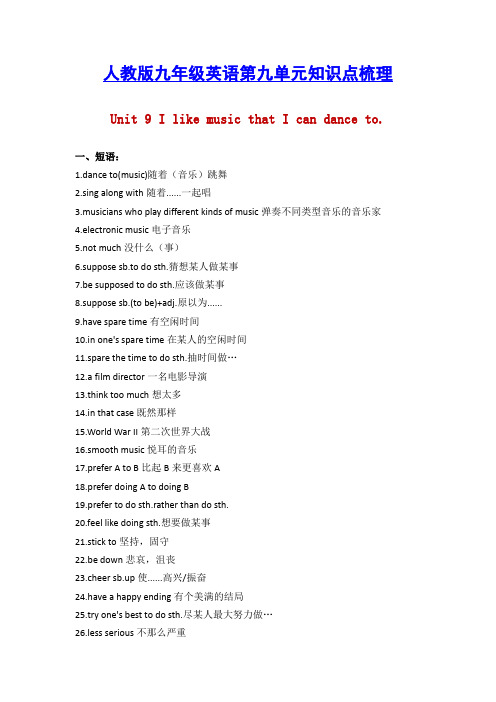
人教版九年级英语第九单元知识点梳理Unit 9 I like music that I can dance to.一、短语:1.dance to(music)随着(音乐)跳舞2.sing along with随着......一起唱3.musicians who play different kinds of music弹奏不同类型音乐的音乐家4.electronic music电子音乐5.not much没什么(事)6.suppose sb.to do sth.猜想某人做某事7.be supposed to do sth.应该做某事8.suppose sb.(to be)+adj.原以为......9.have spare time有空闲时间10.in one's spare time在某人的空闲时间11.spare the time to do sth.抽时间做…12.a film director一名电影导演13.think too much想太多14.in that case既然那样15.World War II第二次世界大战16.smooth music悦耳的音乐17.prefer A to B比起B来更喜欢A18.prefer doing A to doing B19.prefer to do sth.rather than do sth.20.feel like doing sth.想要做某事21.stick to坚持,固守22.be down悲哀,沮丧23.cheer sb.up使......高兴/振奋24.have a happy ending有个美满的结局25.try one's best to do sth.尽某人最大努力做…26.less serious不那么严重27.a good way to do sth.做某事的好办法28.make me feel even sadder让我感觉更伤心29.provide plenty of information about a certain subject提供了大量的关于某个主题的信息30.shut off my brain关闭我的大脑【语法重点】第九单元的语法重点是:定语从句。
九年级英语上册第九单元词汇Unit9

九年级英语上册第九单元词汇Unit9Unit 9词汇篇重点词组1. sing along with 跟着⼀起唱2. the music that can dance to 能跟着跳舞的⾳乐3. play different kind of music演奏不同种类的⾳乐4. a long week at work ⼀周长时间的上班5. have spare time有空闲时间6. in that case 如果那样的话7. feel like doing sth感觉想做某事8. stick to坚持,固守9. have a happy ending有⼀个快乐的结局10. seem less serious似乎不严重11. plenty of ⼤量,充⾜12. shout off 关闭13. once in a while 偶尔,间或14. write their own lyrics ⾃⼰作词15. sing the words clearly 唱词清楚16. Chinese folk music 中国民俗⾳乐17. sense a strong sadness and pain感觉到⼀种强烈的悲伤与痛苦18. look up 查阅19. in total 总计20. China’s national treasures 中国的民族瑰宝21. spread joy传播快乐22. do an excellent job表现优异23. play the hero扮演英雄⼈物24. during his lifetime 在他⽣前语⾔知识点1. Hmm, depends which movie.1) 本句省略了depends前的主语it和which movie后的从句部分we’ll watch,这是典型的⼝语表达形式。
在⼝语和⾮正式场合,为保持语⾔简洁明了,交流者往往会省略彼此所知或逻辑上可明确推断的内容。
九年级英语全一册第九单元单词
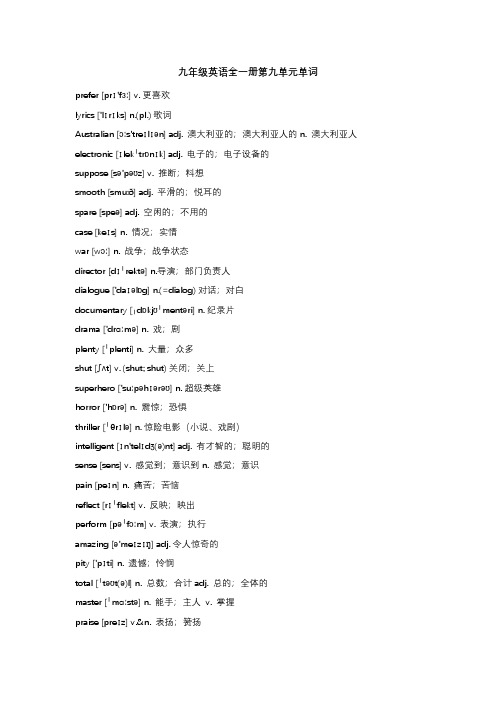
九年级英语全一册第九单元单词prefer [prɪ'fɜː] v. 更喜欢lyrics ['lɪrɪks] n.(pl.) 歌词Australian [ɔːs'treɪlɪən] adj. 澳大利亚的;澳大利亚人的n. 澳大利亚人electronic [ɪlekˈtrɒnɪk] adj. 电子的;电子设备的suppose [sə'pəʊz] v. 推断;料想smooth [smu:ð] adj. 平滑的;悦耳的spare [speə] adj. 空闲的;不用的case [keɪs] n. 情况;实情war [wɔː] n. 战争;战争状态director [dɪˈrektə] n.导演;部门负责人dialogue ['daɪəlɒg] n.(=dialog) 对话;对白documentary [ˌdɒkjʊˈmentəri] n. 纪录片drama ['drɑːmə] n. 戏;剧plenty [ˈplenti] n. 大量;众多shut [ʃʌt] v. (shut; shut) 关闭;关上superhero ['suːpəhɪərəʊ] n. 超级英雄horror ['hɒrə] n. 震惊;恐惧thriller [ˈθrɪlə] n. 惊险电影(小说、戏剧)intelligent [ɪn'telɪdʒ(ə)nt] adj. 有才智的;聪明的sense [sens] v. 感觉到;意识到n. 感觉;意识pain [peɪn] n. 痛苦;苦恼reflect [rɪˈflekt] v. 反映;映出perform [pəˈfɔːm] v. 表演;执行amazing [ə'meɪzɪŋ] adj. 令人惊奇的pity ['pɪti] n. 遗憾;怜悯total [ˈtəʊt(ə)l] n. 总数;合计adj. 总的;全体的master [ˈmɑːstə] n. 能手;主人v. 掌握praise [preɪz] v.&n. 表扬;赞扬。
初中九年级英语第九单元知识点总结(完整版)

初中九年级英语第九单元知识点总结(完整版)====================第一节语法知识点------------1. 过去进行时- 表示过去某个时刻或某段时间正在进行的动作或事件。
- 结构:主语 + was/were + 动词的ing形式。
- 示例:She was cooking dinner when I arrived.2. 定语从句- 用于修饰一个名词或代词的从句。
- 结构:关系代词/关系副词 + 主句。
- 示例:The book that is on the table is mine.3. 可数名词与不可数名词- 可数名词可以用数字进行计数,不可数名词不能。
- 示例:There are three apples on the table. (可数名词)I need some water. (不可数名词)第二节词汇知识点------------1. 常用的形容词- happy, sad, interesting, boring, beautiful, handsome, kind, friendly, etc.- 示例:She is a beautiful girl.2. 常用的动词短语- get up, go to school, have breakfast/lunch/dinner, study English, play basketball, etc.- 示例:I usually get up at 7 o'clock.3. 常用的副词- slowly, quickly, happily, sadly, well, badly, etc.- 示例:He runs quickly.第三节交际知识点------------1. 表示需要帮助- Can you help me, please?- Is there anyone who can help me?2. 表示感谢- Thank you very much for your help.- I really appreciate your assistance.3. 请求解释- Can you explain it to me, please?- Could you clarify this for me?以上是初中九年级英语第九单元的知识点总结。
人教版英语九年级Unit9单元知识点归纳

人教版英语九年级Unit9单元知识点归纳Unit 9: Describing PeopleIn Unit 9, we have learned various vocabulary and grammar structures related to describing people. This unit is important for building our English language skills and expanding our ability to communicate effectively about appearances and personalities. In this article, we will summarize the key points and takeaways from Unit 9 of the People's Education Edition's 9th-grade English curriculum.1. Physical Appearance- We learned words to describe physical appearance such as tall, short, thin, and overweight.- Adjectives like beautiful, handsome, and attractive were introduced to describe people's appearances.- Vocabulary related to different facial features, hairstyles, and clothing styles were covered.2. Personality Traits- Unit 9 provided us with a wide range of vocabulary to describe personality traits, including adjectives like friendly, outgoing, shy, and confident.- We also learned words to describe someone's behavior, such as kind, helpful, and supportive.- Understanding and using these vocabulary words will enable us to accurately describe others' personalities in conversations and discussions.3. Comparing and Contrasting- In Unit 9, we learned comparative and superlative forms of adjectives to compare people's appearances and personalities.- By using structures like "as...as," "more...than," and "the most/the least," we can express similarities and differences between individuals.4. Asking and Answering Questions- The unit taught us useful questions and responses to inquire about someone's appearance and personality.- Question forms like "What does he/she look like?" and "What ishe/she like?" were introduced.- We also practiced forming complete responses to accurately describe people based on the information given.5. Writing Descriptions- Throughout Unit 9, we practiced writing descriptive paragraphs about people.- The paragraphs included details about appearance, personality, and any other relevant information.- We learned to organize our thoughts and use appropriate vocabulary and grammar structures to effectively convey our descriptions.6. Role Plays and Activities- Unit 9 included various role-plays and activities to engage us in practicing the new vocabulary and structures.- These activities aimed to provide real-life situations where we could apply what we learned.- By participating in these activities, we gained confidence in describing people in English.In conclusion, Unit 9 of the 9th-grade People's Education Edition English curriculum focused on teaching us how to describe people effectively. We learned new vocabulary related to physical appearance and personality traits and practiced using them in conversations and written descriptions. By studying this unit, we have enhanced our ability to describe others accurately and expanded our overall language skills.。
【更新】人教版七年级下册英语Unit9第九单元优秀教案
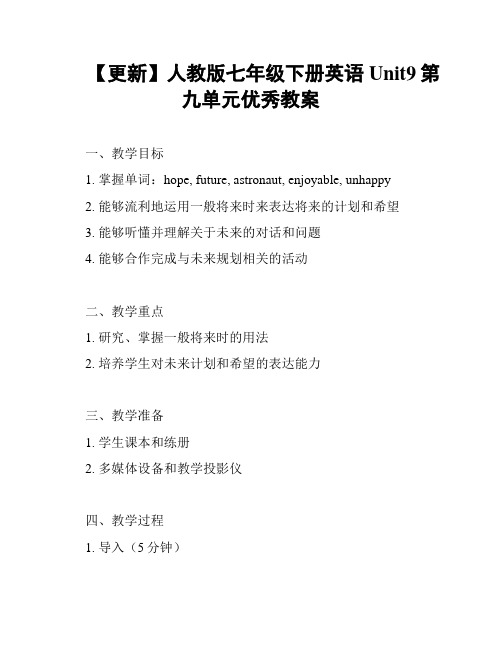
【更新】人教版七年级下册英语Unit9第九单元优秀教案一、教学目标1. 掌握单词:hope, future, astronaut, enjoyable, unhappy2. 能够流利地运用一般将来时来表达将来的计划和希望3. 能够听懂并理解关于未来的对话和问题4. 能够合作完成与未来规划相关的活动二、教学重点1. 研究、掌握一般将来时的用法2. 培养学生对未来计划和希望的表达能力三、教学准备1. 学生课本和练册2. 多媒体设备和教学投影仪四、教学过程1. 导入(5分钟)引导学生讨论一下他们的未来计划和希望,激发学生研究的兴趣和积极性。
2. 教学主体(30分钟)a. 复和引入新知识通过多媒体展示相关图片,引入新单词和短语,并帮助学生掌握其含义。
b. 教授一般将来时的用法详细解释一般将来时的构成和用法,例如:主语 + will + 动词原形。
通过示例句子和练帮助学生理解和掌握。
c. 练与拓展让学生进行口头和书面练,练运用一般将来时进行句子构造和对话。
同时,组织小组活动,让学生合作讨论自己的未来计划。
3. 巩固与反馈(15分钟)通过问题和对话练,巩固学生对一般将来时的掌握程度。
同时,对学生的合作活动进行评价,并给予反馈和鼓励。
五、教学延伸鼓励学生在家进行额外的练,巩固所学的知识。
可以提供一些相关的练题和研究资源。
六、教学评价通过对学生的口头和书面练进行评价,了解学生对一般将来时的掌握程度,并给予针对性的指导。
七、教学反思根据教学实际情况,对本节课的教学效果进行总结和反思,为下一次教学做出调整和提升。
八、课后作业完成课本和练习册上相关的练习题,并继续思考自己的未来计划和希望。
初二英语上册第九单元知识点讲解

初二英语上册第九单元知识点讲解一.本单元知识讲解☜第9单元重点短语☞1. Who is that? 用来询问对方的姓名和身份,回答时用That/It作主语。
eg. Who is that? It is Wang Nan.Who is that? That is Wang Wei, a famous singer.练习——_____ is that?——That is our English teacher.A. WhenB. What timeC. WhoD. Why2. be born 出生于一般用于过去时态,也可用于将来时。
eg. Micheal Jordan was born in 1963.I was born in Beijing on October 1, 2000.Her baby will be born next month.She was born in a small village.练习——_____ she _____ in this city?——Yes, she was.A. Where; bornB. Was; bornC. When; bornD. Were; born3. start 开始,与begin同意,其后可接名词、动名词、动词不定式eg. Shall we start/begin our dinner?My brother started playing/to play on the computer.He’ll begin/start working this week.start表机器开动、创办、动身时,不可与begin替换eg. The man can’t start the car.He started a new shop last year.We must start early.练习(威海中考)Maybe there is something wrong with my car. I can’t ____ it.A. moveB. beginC. startD. work4. stop doing sth The baby stop crying.stop to do sth The baby stop to cry.forget doing sth I forget doing my homework.forget to do sth I forget to do my homework.remember doing sth I remember doing my homework.remember to do sth I remember to do my homework.go on doing sth The baby go on crying.go on to do sth The baby go on to cry.练习1. (四川中考)They are too tired, so they stop _____ and have a rest.A. workingB. to workC. work2. Can you stop _____ (help) me? It is too heavy for me to carry.3. (烟台中考)Stop _____ so much noise! My father is sleeping.A. to makeB. makingC. to hearD. hearing4. (北京朝阳中考)当老师走进教室时,学生们立刻停止了谈话。
人教版九年级英语第九单元知识点总结

人教版九年级英语第九单元知识点总结
人教版九年级英语第九单元的知识点总结如下:
1. 词汇和短语:
用法:掌握并能够正确使用本单元所学的词汇和短语,包括它们的拼写、发音和用法。
扩展:通过阅读、写作和听力练习,进一步加深对词汇和短语的掌握。
2. 语法:
现在完成时态:掌握现在完成时态的基本用法,了解其与一般过去时的区别。
常用表达方式:熟悉并掌握一些常用的表达方式,如“so far”、“up to now”、“in the past few years”等。
3. 课文理解:
主题:理解本单元课文的主题,了解不同国家的文化习俗和传统。
细节:能够准确提取课文中的关键信息,理解文章的基本结构和逻辑关系。
4. 口语练习:
常用表达:通过模仿和练习,能够流利地使用本单元所学的日常用语和表达方式。
情景对话:能够在不同的情境下进行有效的交流和沟通,提高口语交际能力。
5. 写作练习:
段落结构:了解并掌握段落的基本结构,能够写出结构清晰、逻辑严谨的段落。
写作技巧:学习并运用一些常用的写作技巧,如转折、因果、比较等,提高写作水平。
6. 听力练习:
听力理解:通过听录音、看视频等方式,提高听力理解能力。
信息提取:能够从听力材料中提取关键信息,并进行归纳总结。
7. 阅读练习:
阅读技巧:掌握一些常用的阅读技巧,如略读、寻读、精读等,提高阅读速度和理解能力。
扩展阅读:通过课外阅读等方式,了解更多不同国家和地区的文化传统和习俗。
- 1、下载文档前请自行甄别文档内容的完整性,平台不提供额外的编辑、内容补充、找答案等附加服务。
- 2、"仅部分预览"的文档,不可在线预览部分如存在完整性等问题,可反馈申请退款(可完整预览的文档不适用该条件!)。
- 3、如文档侵犯您的权益,请联系客服反馈,我们会尽快为您处理(人工客服工作时间:9:00-18:30)。
Text 9
Now the tide appears to be turning. As personal injury claims continue as before. some courts are beginning to side with defendant s, especially in cases where a warning label probably wouldn't have changed anything.
In May, Julie Nimmons, president of Schutt Sports in Illinois, successfully fought a lawsuit involving a football player who was paralyzed in a game while wearing a Schutt helmet. "We're really sorry he has become paralyzed, but helmets aren't designed to prevent those kinds of injuries," says Nimmons. They jury agreed that the nature of the game, not the helmet, was the reason for the athlete's injury.
At the same time, the American Law Institute —a group of judges, lawyers, and academics whose recommendation s carry substantial weight — issued new guideline s for tort law stating that companies need not warn customers of obvious dangers or bombard them with a lengthy list of possible ones. "Important information can get buried in a sea of trivialities," says a law professor at Cornell Law School who helped draft the new guidelines. If the moderate end of the legal community has its way, the information on products
might actually be provided for the benefit of customers and not as protection against legal liability.。
